Clyde Butcher is one of America's acclaimed environmental artists. Some people call him the Ansel Adams of the Everglades. But his technique is so largely based on intuition that he describes himself as a "point-and-shoot" photographer.

Little Butternut Key, Florida ( c) Clyde Butcher
Butcher is one of the most visible (and visual) campaigners for the protection and restoration of Florida's unique wetlands. Using large format cameras (ranging from 4 x 5 inches to 12 x 20) and very long exposure times (one second to six minutes), he works only in black and white.
In our handheld digital age -- where lightweight makes right -- , he carts around as much equipment as Louis Daguerre. (Slight exaggeration, but his gear does weigh 100-125 pounds.)
He's been profiled in a PBS special, helped make four more PBS documentaries, and has received numerous honors, including being inducted into the Florida Artists Hall of Fame and receiving the Sierra Club's Ansel Adams award.
And all this without composing through the lens on his camera.
"Put tape over your viewfinder"
In fact, during a lecture this month at the Annenberg Space for Photography in Los Angeles, Butcher advised aspiring photographers to begin by not looking through the lens. Here's a video excerpt of his talk.
Annenberg Space For Photography, IRIS Nights Lecture, Clyde Butcher from Annenberg Space for Photography on Vimeo.
His point is that when it comes to landscape photography, the most important relationship is not between the photographer and the camera, it's between photographer and nature.
(I recommend watching a remarkable video available on-line that is part of the Annenberg exhibition. It's called the Voice of the Photographer and gives great insight into Butcher's darkroom philosophy.)
Butcher is one of five featured photographers in the current multimedia Annenberg exhibition, Extreme Exposure. It celebrates five photographers who "thrive in environments that few dare to explore." His large photographs often reveal intricate detail as well as expansive spaces in the natural world of the Everglades.
Sometimes he "stalks" an image for years. He worked on a series of photos about the Loxahatchee River off and on for three years waiting for the right conditions. In the photograph below, the exposure was so long -- an astounding six minutes - he had to float in the water so as not to jar the camera.
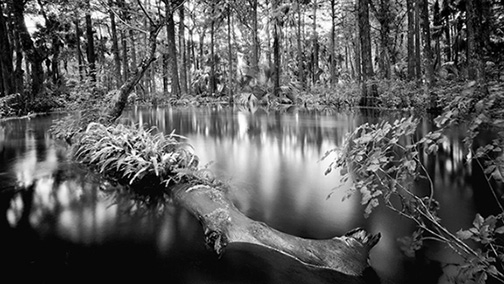
Loxahatchee River (c) Clyde Butcher. Butcher says the very long exposure tends to make moving water look like ice, but in fact as he floated for the six minute exposure, he could see tiny ripples on the water emanating from his beating heart. Call it full-immersion photography if you like. Butcher says such an approach allows him to feel "at one" with the river and helps him find his shots. Oh, and yes, there are alligators in the Loxahatchee. Butcher calls the river "gatorful."
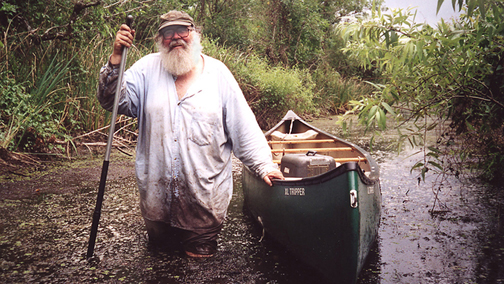
Clyde Butcher "canoeing" down the Turner River (c) Niki Butcher. Butcher almost always goes on his photographic expeditions with his wife, Niki. With no roads or paths, he often makes his way by slogging through water with his hefty gear safe in a canoe. No idea who does his shirts.
"Feeling" A Shot
Butcher is straight-forward about his art. Here is another clip on his approach.
Annenberg Space For Photography, IRIS Nights Lecture, Clyde Butcher, Clip 2 from Annenberg Space for Photography on Vimeo.
In an interview before his lecture, he told me about "feeling" a shot.
"It's interesting when I'm walking through the swamp or whatever and I come to a place and it's like embracing nature. And people say how do you photograph it? ... I feel a shot. I feel an image. I just set the tripod down and the camera down and focus. I don't compose with the camera. The camera is set up when I feel it is right. My grandmother and her sister were psychics and I think I have some of that. I just have a some sort of spiritual connection with nature."
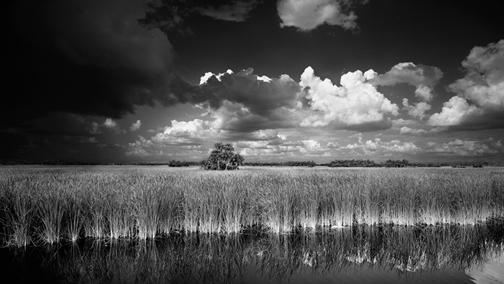
Ochopee (c) Clyde Butcher. Known as the River of Grass, the Everglades is "a freshwater habitat larger than the state of Connecticut." That's a quote from a traveling exhibition Butcher co-produced with the Center for Science. Butcher is working on telling the full Everglades story through his pictures, which range from the headwaters in the shallow lakes of Florida through the swamps to the mangroves. Butcher says there is water everywhere and it is often crystal clear.
"Angle of View"
When photographing, he sticks his arms out to find his "angle of view."(See video above for a demonstration.) He says it's usually about a 100 degrees. This "angle of view" is one of the keys to understanding his work. We had this exchange:
Butcher: I can't tell you how many people who are with me when I take the photograph and when I take the picture and develop the print, they will swear that they weren't there.
Me: Why do you reckon that is?
Butcher: Because they can't see it. They can't feel it. It's amazing. They'll insist 'I was not there. I was not there when you took this.'
Me: Isn't that saying that a lot of creating something is the ability to see?
Butcher: Feel. You're seeing obviously. But you feel the shot. People don't understand the angle of view that they see. You know what angle of view you see? 5 degrees. So you have to scan and you see it as you scan. So for me it's basically a feeling because you can't see it.
And why is this important? Well, because it leads back to nature - as many things do for Butcher.
"You Have to Think About Being There"
A member of the audience at the Annenberg Space for Photography asked Butcher why he printed his photos so large -- some as big as 5 x 9 feet. (I urge you to experience them face to face.) This was his answer:
"I make photos large because you can't see them. You have to experience it, you have to scan it. You have to think about being there."
Butcher's aim is not just to make art in the wilderness. He wants to bring you back there with him.
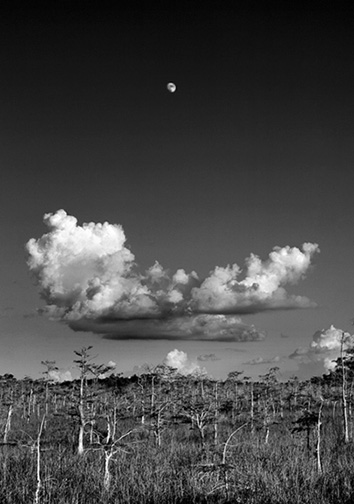
Moonrise (c) Clyde Butcher
Above you'll see the first photo Butcher made in the style that has become his hallmark. Black and white. Large format. Florida's Everglades. He made it in 1986, near his home at Big Cypress. Just after his son died. Butcher picks up the story.
"My son was killed. That was a tough time. Drunk driver hit him. He was 17. A lot of people really lose it at that time. Where for us [he and his wife Niki] it was important to be positive. And do something positive for the world instead of being a negative person. And actually Ive expanded my teachings and my environmental stuff because of that. Before my son was killed, I wouldn't do projects unless there was money involved. Now, if a conservation person wants to use my photograph, it's free If a goverrnment agency wants to use my work, it's free. I've worked on 5 PBS specials [also for free] ... because I'm trying to spread the word on how great the universe is."
In the notes for the Annenberg exhibit, Butcher goes further.
"Wilderness, to me, is a spiritual necessity. The mysterious spiritual experience of being close to natural restored my soul [after the death of his son]. My experience reinforced by dedication to use the art of photography as an inspiration for others to work together to save nature's places of spiritual sanctuary for future generations."
Yosemite, Ansel Adams & Love
Butcher says he first became aware of Ansel Adams' work in Yosemite in 1961. "I was dating my wife [Niki] there. So there's a connection between discovering landscape photography and discovering my wife."
The process of discovery continues, as evidenced below by his stunning photograph of Yosemite Valley taken in 2010 and the lovely and loving portrait Niki took of him as he worked there.
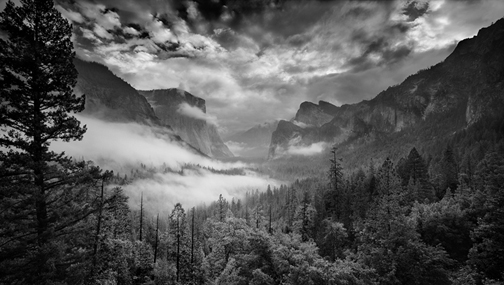
Inspiration Point, Yosemite (c) Clyde Butcher. Patience is central to Butcher's work. He waited hours for the fog to lift to make this exposure.
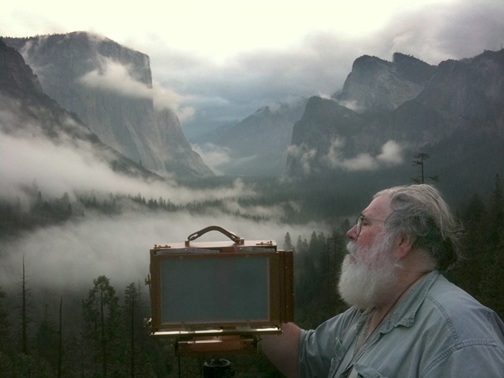
The artist at work as he made the above image. (c) Niki Butcher. -- The Butchers have been married 47 years. "Without my wife I couldn't do this. Niki is an artist, too. Between the two of us, we're quite a team."
"Everything Comes Round"
Butcher has a clear goal with his photography. He wants to inspire people to protect our environment. And he feels he should do his part, too.
"We just built a new house. 940 square feet. Hurricane windows which are insulating. 4600 watts of solar on the roof. Every light in the house is LED We have 32 lights. If you turn every light on, it's 160 watts. And it's beautiful light... Our gallery in Big Cypress is all LEDs ... 130 watts."
Butcher says he will save more than $40,000 in electricity and bulb replacement over the life of the LEDs. His current electricity bill is $12 a month.
"People think of everything today on the short term," Butcher says. "And they have no concept of tomorrow. And that's one of the problems... I'm doing everything I can do to still be in human society and still have the smallest impact I can."
Butcher is dedicated to black and white as a photographer. And yet he ended his lecture in Los Angeles with a color shot. The now familiar photo from space showing the Earth as a miraculous living marble of blue against the black of space.
"The world is round and everything we do comes around. This is the place where our home is. We have to be careful with it."
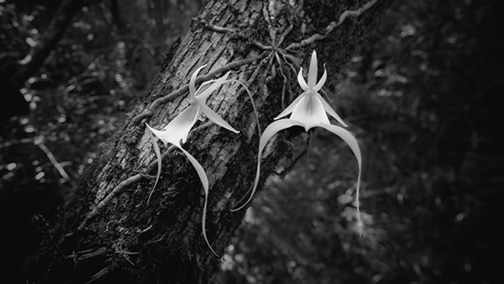
Ghost Orchid Twins, Fakahatchee Strand (c) Clyde Butcher.
Disclosure: Huffington Post is a sponsor of the current exhibition running at the Annenberg Space for Photography -- "Extreme Exposure."